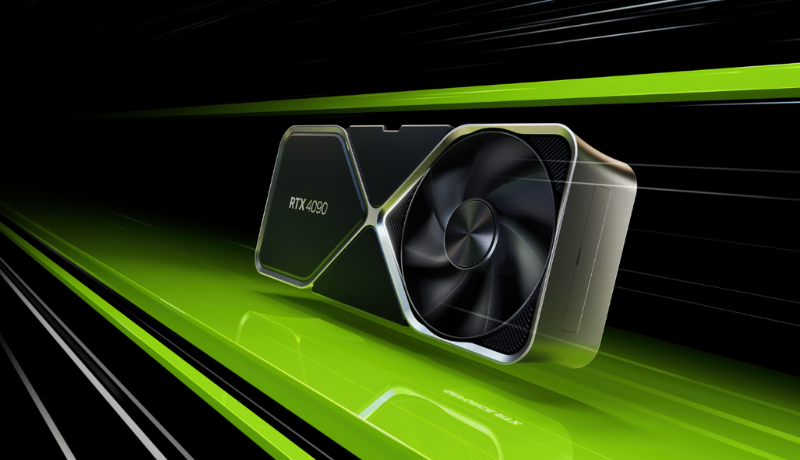
NVIDIA unveiled the GeForce RTX® 40 Series of GPUs, which are designed to deliver revolutionary performance for gamers and creators, led by the RTX 4090 GPU, which has up to four times the performance of its predecessor.
The RTX 40 Series, the world’s first GPUs based on the new NVIDIA® Ada Lovelace architecture, delivers massive generational leaps in performance and efficiency, ushering in a new era of real-time ray tracing and neural rendering, which uses AI to generate pixels.

“The age of RTX ray tracing and neural rendering is in full steam, and our new Ada Lovelace architecture takes it to the next level,” said Jensen Huang, NVIDIA’s founder and CEO, at the GeForce® Beyond: Special Broadcast at GTC.
“Ada provides a quantum leap for gamers and paves the way for creators of fully simulated worlds. With up to 4x the performance of the previous generation, Ada is setting a new standard for the industry,” he said.
Huang also unveiled NVIDIA DLSS 3, the company’s next generation of Deep Learning Super Sampling neural-graphics technology for games and creative apps. AI-powered technology can generate entire frames, allowing for much faster game play. It allows the GPU to generate entire frames independently, allowing it to overcome CPU performance limitations in games.
The technology is making its way to the world’s most popular game engines, including Unity and Unreal Engine, and has received support from many of the world’s leading game developers, with more than 35 games and apps on the way.
Additionally, the RTX 40 Series GPUs feature a range of new technological innovations, including:
For decades, rendering ray-traced scenes with physically correct lighting in real time has been considered the holy grail of graphics. At the same time, geometric complexity of environments and objects has continued to increase as 3D games and graphics strive to provide the most accurate representations of the real world.
Creating physically accurate graphics necessitates a massive amount of computational power. Modern ray-traced games, such as Cyberpunk 2077, perform over 600 ray-tracing calculations for each pixel just to determine lighting, which is a 16x improvement over the first ray-traced games released four years ago.
The new third-generation RT Cores have been enhanced to deliver 2x faster ray-triangle intersection testing and include two important new hardware units. An Opacity Micromap Engine speeds up ray tracing of alpha-test geometry by a factor of 2x, and a Micro-Mesh Engine generates micro-meshes on the fly to generate additional geometry. The Micro-Mesh Engine provides the benefits of increased geometric complexity without the traditional performance and storage costs of complex geometries.
NVIDIA Studio creators benefit from the RTX 40 Series GPUs and DLSS 3. 3D artists can render fully ray-traced environments with accurate physics and realistic materials in real time, without the use of proxies.
Improved GPU performance and the inclusion of new dual eighth-generation AV1 encoders also benefit video editing and live streaming. Three updates to the NVIDIA Broadcast software development kit are now available for partners, including Face Expression Estimation, Eye Contact, and Virtual Background quality improvements.
NVIDIA Omniverse, part of the NVIDIA Studio software suite, will soon include NVIDIA RTX Remix, a modding platform for creating stunning RTX remasters of classic games. Modders can use RTX Remix to quickly capture game assets, automatically enhance materials with powerful AI tools, and enable RTX with ray tracing and DLSS.
NVIDIA Lightspeed Studios used RTX Remix to reimagine Valve’s iconic video game Portal, which is widely regarded as one of the best video games of all time. Full ray tracing and DLSS 3 are among the advanced graphics features that give the game a striking new look and feel. Portal with RTX will be released in November as free, official downloadable content for the classic platformer, just in time for Portal’s 15th anniversary.
The RTX 4090 is the world’s fastest gaming GPU with astonishing power, acoustics and temperature characteristics. In full ray-traced games, the RTX 4090 with DLSS 3 is up to 4x faster compared to last generation’s RTX 3090 Ti with DLSS 2. It is also up to 2x faster in today’s games while maintaining the same 450W power consumption. It features 76 billion transistors, 16,384 CUDA® cores and 24GB of high-speed Micron GDDR6X memory, and consistently delivers over 100 frames per second at 4K-resolution gaming. The RTX 4090 will be available on Wednesday, Oct. 12, starting at $1,599.
The company also announced the RTX 4080, launching in two configurations. The RTX 4080 16GB has 9,728 CUDA cores and 16GB of high-speed Micron GDDR6X memory, and with DLSS 3 is 2x as fast in today’s games as the GeForce RTX 3080 Ti and more powerful than the GeForce RTX 3090 Ti at lower power. The RTX 4080 12GB has 7,680 CUDA cores and 12GB of Micron GDDR6X memory, and with DLSS 3 is faster than the RTX 3090 Ti, the previous-generation flagship GPU.
Both RTX 4080 configurations will be available in November, with prices starting at $1,199 and $899, respectively.
The GeForce RTX 4090 and 4080 GPUs will be available as custom boards, including stock-clocked and factory-overclocked models, from top add-in card providers such as ASUS, Colorful, Gainward, Galaxy, GIGABYTE, Inno3D, MSI, Palit, PNY and Zotac.
The RTX 4090 and RTX 4080 (16GB) are also produced directly by NVIDIA in limited Founders Editions for fans wanting the NVIDIA in-house design.
Look for the GeForce RTX 40 Series GPUs in gaming systems built by Acer, Alienware, ASUS, Dell, HP, Lenovo and MSI, leading system builders worldwide, and many more.
